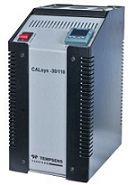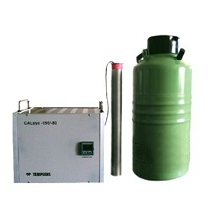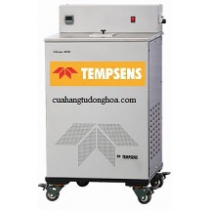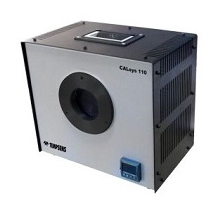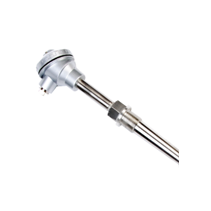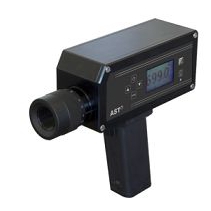CALsys -30/110 Tempsens Instrument Việt Nam
Công Ty TNHH TM và DV Tăng Minh Phát là nhà phân phối chính thức của hãng Tempsens Instrument tại Việt Nam.
CALsys -30/110 Tempsens Instrument Việt Nam
CALsys -30/110 CALsys -15/110 CALsys -120SP CALsys -250 CALsys -650 CALsys -1200
An evaluation report of the CALsys -30/110 Dry block bath
Manufactured by Tempsens Instruments (II) Pvt Ltd
INTRODUCTION
The CALsys -30/110 is the latest version of Tempsens most popular High Accuracy Dry Block calibration Bath. It works over the temperature range -30 Deg C to 110 Deg C.
At Tempsens it is our earnest desire to present for our customer’s consideration as much useful information as possible and to this end we have spent a substantial amount of time evaluating our products.
The results of the evaluation of an Accuracy liquid calibration Bath can be presented in many formats some of which will give an optimistic or indeed a pessimistic view of how the products operate.

A. Radial Temperature Homogeneity:
What is Radial Temperature Homogeneity and why it is important to measure
Radial uniformity refers to temperature differences between wells of the block or sleeve. This nonuniformity is strongly influenced by the difference between the block and ambient temperature. A larger temperature difference from ambient will result in a larger potential temperature calibration error. Therefore radial inhomogeneity should be measured at extremes (relative to ambient temperature) in an instrument’s temperature range.
Test method:
The temperature differences between the zones in the individual bores provided for the measurements are measured with one or several suitable thermometers at three different temperature representative of the field of application and covering the extreme temperature which may occur. If there is only one bore no measurement has to be carried out.
For CALsys -30/110, we consider -30 Deg C, 0 Deg C and 110 Deg C respectively. As example at 50 Deg C two RTD (designed for small steam conduction) were placed in each of the holes. Measurements were recorded and then the probes were interchanged between the two pockets and repeat measurements made. The temperature Difference was calculated to remove the small offsets between the two probes.
For calibrators having fewer than four wells, it may be necessary to determine differences by cyclic exchange. The difference between two wells with two thermometers may be determined with the following Formula:
Temperature Difference = [((P1W1 – P1W2) + (P2W1 - P2W2)) / 2}]
Note: P1 = probe 1, W1 = well 1 and so on. P1W1 is read as the value of probe 1 in well 1.
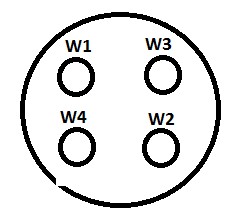
Radial Temperature Homogeneity at CALsys -30/110
|
Temp (Deg C) |
Sensor |
Hole 1 |
Hole 3 |
|
-30 |
RTD Sr.No. 438 |
-30.550 |
-30.610 |
|
RTD Sr.No. 4391 |
-30.582 |
-30.640 |
|
|
Radial Uniformity : +/-0.059 |
|||
|
Temp (Deg C) |
Sensor |
Hole 1 |
Hole 3 |
|
0 |
RTD Sr.No 438 |
-0.33 |
-0.21 |
|
RTD Sr.No 4391 |
-0.35 |
-0.31 |
|
|
Radial Uniformity : +/-0.07 |
|||
|
Temp (Deg C) |
Sensor |
Hole 1 |
Hole 3 |
|
110 |
RTD Sr.No. 438 |
110.66 |
110.69 |
|
RTD Sr.No. 4391 |
110.64 |
110.75 |
|
|
Radial Uniformity : +/-0.07 |
|||
B. Temperature Stability
Temperature stability is measured with a thermometer and readout with adequate sensitivity and resolution to measure the control fluctuations in the block. A typical time period for stability measurements of a dry-well is about 30 minutes at any specific temperature. Other time periods may be applied depending on how the calibrator is to be used. Temperature stability may vary at different temperatures. The instrument should be characterized over its range, and typically three sets of stability measurements are adequate. Dry-wells that are heated only (that is they utilize no cooling systems to achieve below-ambient temperatures) are measured at their maximum and minimum temperatures and at the midpoint of their ranges. Stability measurements for cold dry- wells are made at their maximum and minimum temperatures as well as near room temperature. Specific temperatures of interest by the user may also be incorporated.
Test Method:
Stability is the measure of the temperature deviations over the measurement period, after temperature control has stabilized. The stability data can be viewed in two ways (see Figure 3). What may be called “peak” stability is often evaluated as plus or minus (±) one-half the difference between of the maximum and minimum values of the data set:
Peak Stability = ± (Tmax – Tmin) / 2.
|
Temp Set Point |
Maximum |
Minimum |
Peak Stability |
|
-30 Deg C |
-30.70 |
-30.69 |
0.005 |
|
0 Deg C |
-0.41 |
-0.39 |
0.010 |
|
110 Deg C |
110.70 |
110.68 |
0.010 |
LOW TEMPERATURE DRY BLOCK CALIBRATOR Calsys -30/110 is low temperature dry block furnace. The dry block furnace based on thermoelectric cooling circuitry. This model provides an special design isothermal enclosure ( Aluminium block) in which the thermocouple/RTD can be calibrated against the temperature of the calibrator. The calibrator controller uses a precision RTD as a controlling sensor and controls the well temperature with thermoelectric cooler. To obtain and maintain a required temperature the controller varies the power to the heater via solid-state relay. There is one electricity driven fan which is situated under the heating chamber for cooling the heater. The dry block calibrator was designed for portability, moderate cost and ease of operation.
KEY FEATURES
Wide Operating Range (-30 to110°C)
High Stability
PC Interfacing
Simple to use and cost effective
Portability
Low temperature calibration facility upto -30°C
Conveniently handle and calibration
Light Weight
Temperature Range : -30 to 110 °C
Temperature Resolution : 0.1°C
Stability : ±0.04°C at -30°C±0.06°C at 0°C±0.07°C at 110°C
Uniformity : ±0.05°C at -30°C±0.07°C at 0°C±0.08°C at 110°C
Controlling Sensor : Precision PRT
Method of Control : Digital self tunedPID Controller
Fixed Insert Construction : 1 hole of 8mm and 2 hole of 6.5mm with 120mm length
Time to Reach Max/Min Temp : 10/20 Mins
Operating Temperature : 20 to 25°C
Computer Interface : RS - 232
Power Requirement : 230 VAC, 500 W
Dimensions : 380(H) x 170(W) x188(D) mm
Weight : 11.70Kg (without packing)
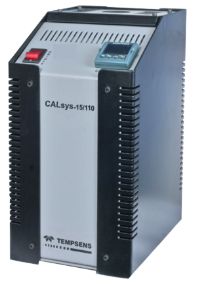


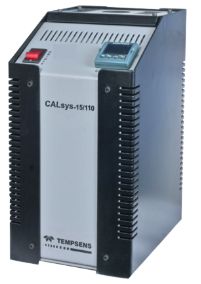
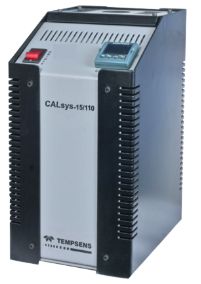
CALsys -15/110
Temperature Range:
-15 to 110°C
Stability:
±0.03°C
Temperature Resolution:
0.1°C
CALsys 120SP (Dry cum Liquid Bath)
Temperature Range:
0 to 120°C
Stability:
±0.03°C
Uniformity:
±0.05°C
Temperature Resolution:
0.1°C
CALsys 250
Temperature Range:
50 to 250°C
Stability:
±0.015°C
Uniformity:
±0.02°C
Temperature Resolution:
0.1°C
CALsys 650
Temperature Range:
50 to 650°C
Stability:
±0.025°C
Uniformity:
±0.04°C
Temperature Resolution:
0.1°C
CALsys 1200
Temperature Range:
250 to 1200°C
Stability:
±0.1°C
Uniformity:
±0.2°C
Temperature Resolution:
1.0°C
- 4Matic Valves
- AuCom
- ADVEL
- Aichi Tokei Denki
- Autrol
- AEG
- BEKO TECHNOLOGIES
- BOURNS
- BRUEL & KJAER VIBRO
- Badotherm
- Brooks Instrument
- CHECKLINE
- CS Instruments
- CEIA
- COMET
- CEMB
- DAIICHI ELECTRONICS
- EUROSWITCH
- Econex
- Flownics
- Fox Thermal
- Fotoelektrik Pauly GmbH
- Fireye
- GASTRON
- GINICE
- HBM
- IBA
- IWATSU
- INSERT DEAL
- INDRA
- IPF ELECTRONIC
- IMI NORGREN
- KOGANEI
- KIEPE ELEKTRIK
- KOMETER
- LEINE LINDE
- Lika
- Lapar Valve
- Matsushima
- MTS Sensor
- METRIX
- MARK-10
- MAGNETEK
- MonTech
- mit-UNID-cns
- Maxcess
- MOOG
- NIRECO
- Ohkura
- Puls Power
- PHISHER
- PORA
- PFEIFFER VACUUM
- Pietro Fiorentini
- RIELS
- Rotork
- Redlion
- SUNTES
- SAUTER
- Schenck process
- SensorsONE
- STI
- SENSOREX
- TECLOCK
- TE.MA.VASCONI
- TEMPSENS
- TECH-LAB-SYSTEMS
- Tatronic
- Tek-trol
- Thwing-Albert
- United electric control
- Vibro-Meter®
- von Rohr Armaturen AG
- VEGA
- Vemmtec
- Wilcoxon
- Weintek
- Balluff
- ME SYSTEMSE
- Thiết bị đo lưu lượng
- Thiết bị đo mức
- Thiết bị phát hiện rò rỉ khí
- Thiết bị và hệ thống đo trọng lượng
- Thiết bị phát hiện rò rỉ khí nén
- Thiết bị dùng trong hệ thống điều khiển và tự động hóa
- Flow Technology
- AT2E
- TAY TRANG SPOHN BURKHARDT
- Okazaki
- TWK
- Woma
- MET ONE
- EPI FLOW METER
-
Trực tuyến:10
-
Hôm nay:3705
-
Tuần này:16177
-
Tuần trước:24574
-
Tháng trước:37568
-
Tất cả:4311887




